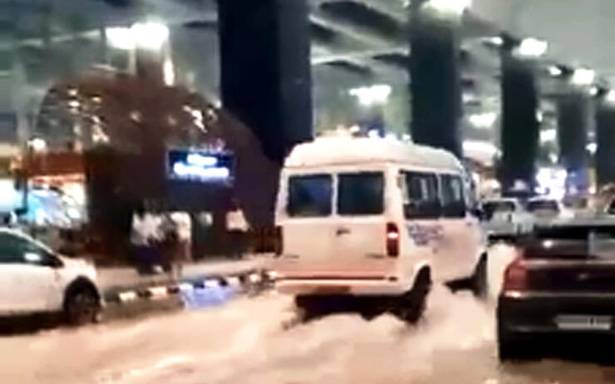“Why is God so angry with us?” asked Manik Pradhan, pointing to the vast tracts ofcropland inundated with dead fish floating around, as nearby ponds have overflown with saline water breaching the embankments.
Picking up a large dead ‘catla’ fish, which would have fetched anywhere between Rs 1,000-1,500 in the wholesale markets of Kolkata, Pronab Mondal said, “Our condition is also like this fish, it died as saline water entered the pond and we are as good as dead after back-to-back disasters. First, it was cyclone Amphan, then COVID and now, Yaas.”
Jana and Mondal are among thousands of people living in the Namkhana block — one of the worst-affected in the Sunderbans region in West Bengal’s South 24 Parganas district who have lost their homes and livelihoods due to the cyclone.
Jana, who lives in the Narayanpur village, was planning to cast the roof of his house this summer with the grant provided by the government.
“I started working on the house last year, completed the structure and got the first tranche of Rs 60,000. A few weeks back, I bought the construction materials and hoped to cast the roof but then the cyclone hit. Everything got washed away,” he said.
“I planted brinjal and sponge gourd this season. Everything is destroyed. I don’t know what will we do for the next one year,” he said, trying hard to hold back his tears.
The highway, which leads to Namkhana and ends at the beach in Bakkhali, was lined with trucks and pick-up vans that came from far and wide with relief materials — the efforts led mostly by community clubs.
Tapas Banerjee was part of one such group that came with dry food and other relief materials all the way from Asansol, around 300 km away.
“We collected relief materials from the people of our area in Burnpur and came here. As part of Nababikash Club, we try to help people throughout the year. Besides, we have given Rs 1 lakh to the state government for the relief efforts,” he said, managing a large queue of people that had gathered for packets of puffed rice, flattened rice and baby food, among others.
“At first, we went to Mousuni Island. What we saw there was horrific — nothing was left. The tourist camps have been swept away. Seawater entered the water bodies where prawns were cultivated, killing all the produce.
“Don’t really know how these people will survive,” Banerjee said, as someone nearby prompted, “We bought 15 kg prawn on our way back at Rs 150 a kg. We couldn’t resist, prawns of this size would usually cost Rs 600-650 per kg.”
Mousuni Island, which has become a popular camping destination over the years, is the most-affected of the seven panchayat areas in Namkhana, Block Development Officer Shantanu Singha Thakur told PTI.
“The population of the block is around 2 lakh as per the 2011 Census and almost 50 per cent of the population is affected. More than the cyclone, the astronomical tide caused by the full moon that day has impacted the area. It is now under control and we are working round the clock,” he said.
“We shifted 62,000 people to rescue centres ahead of the cyclone following all COVID protocols. We are operating 162 community kitchens at present to provide cooked food twice a day, and also giving them snacks,” Thakur said.
Thakur’s office, the field station for the rescue and relief efforts, was also under water till two days back. Most parts of the complex were still inundated with officers often stumbling upon fish such as ‘koi’ and ‘shoal’.
“In the last one week, we barely had time to make out whether it’s day or night outide. We have been working, eating and napping here,” said an officer, pointing to the makeshift bed in his cabin.
“We are trying to reach out to people with all the help as fast as possible. Hopefully, the situation will improve as ‘Mora Kotal’ or low tidal variation has set in,” he said, refusing to be named as he was not authorised to speak to the media.
Overhearing the conversation, a man who worked at the BDO office said, “You should have asked him why is there such a situation every time? Why couldn’t the embankments be made of concrete?
“They will build mud embankments every year and those will be breached. What is the use? We will continue to live like this throughout our lives it seems,” he said before rushing out to help an officer with some work.
Outside the complex, a truck stood with a machine that was churning out drinking water pouches.
If operated from 7 am to 11 pm, it can produce 80-90,000 pouches of 200 ml each. It has come all the way from Burdwan, said the supervisor as he kept a log and prodded the workers to ensure zero wastage.
Besides, 2,000-litre tankers are being sent to the villages on motor-operated vans as a drinking water crisis has engulfed the area.
Shibshankar Mondal, who drives one such van, said though the job was painstaking, it gave him some satisfaction that he was helping people who are facing such hardships.
“I live in Kakdwip block and my house is also under water. But, I could manage to save my van,” said Mondal, who otherwise ferries people.
“These tanks are used during the Gangasagar Mela, and were lying in the store. It’s good that someone thought about using it now,” he said, adding that he was being paid Rs 1,500 per day along with sufficient petrol — a boon given that he earned Rs 700-800 a day earlier, but that stopped owing to the lockdown.
Thakur said drinking water was being provided to 60-70 per cent of the area, as the tube wells were damaged due to the saline water.
“I won’t say that allegations over the embankments are absolutely false. The work is done by the Irrigation Department. We have raised the issue with them. The fact is, a cyclone has hit the area every six months in the last three years; so we couldn’t get the minimum time for implementing a long-term solution,” he said.
“However, the department has been told that new embankments should sustain for long. Also, apart from the breaches, the tidal waves were so huge that water overflowed into the villages. The tidal waves were around 12-13 feet high, and to deal with that, we need to build embankments as high as the Great Wall of China,” the BDO said.
Towards the end of the highway at Bakkhali sea beach, around 25 km away, a few shops selling cold drinks and cigarettes had mounds of sand to fend with.
“The sea waves almost touched the shops one kilometre away. See the mounds of sand inside the fridge. I don’t know how to clean this, and the machine has now stopped working.
“I invested Rs 20,000 for the fridge. If it becomes non-functional, what will I do?” said one of the shopkeepers, as he got busy with a group from Bhangore that went to the beach to bath, after distributing relief materials.




